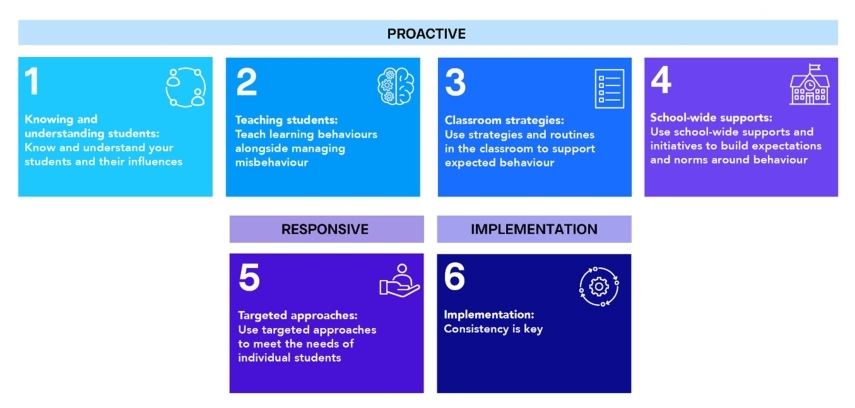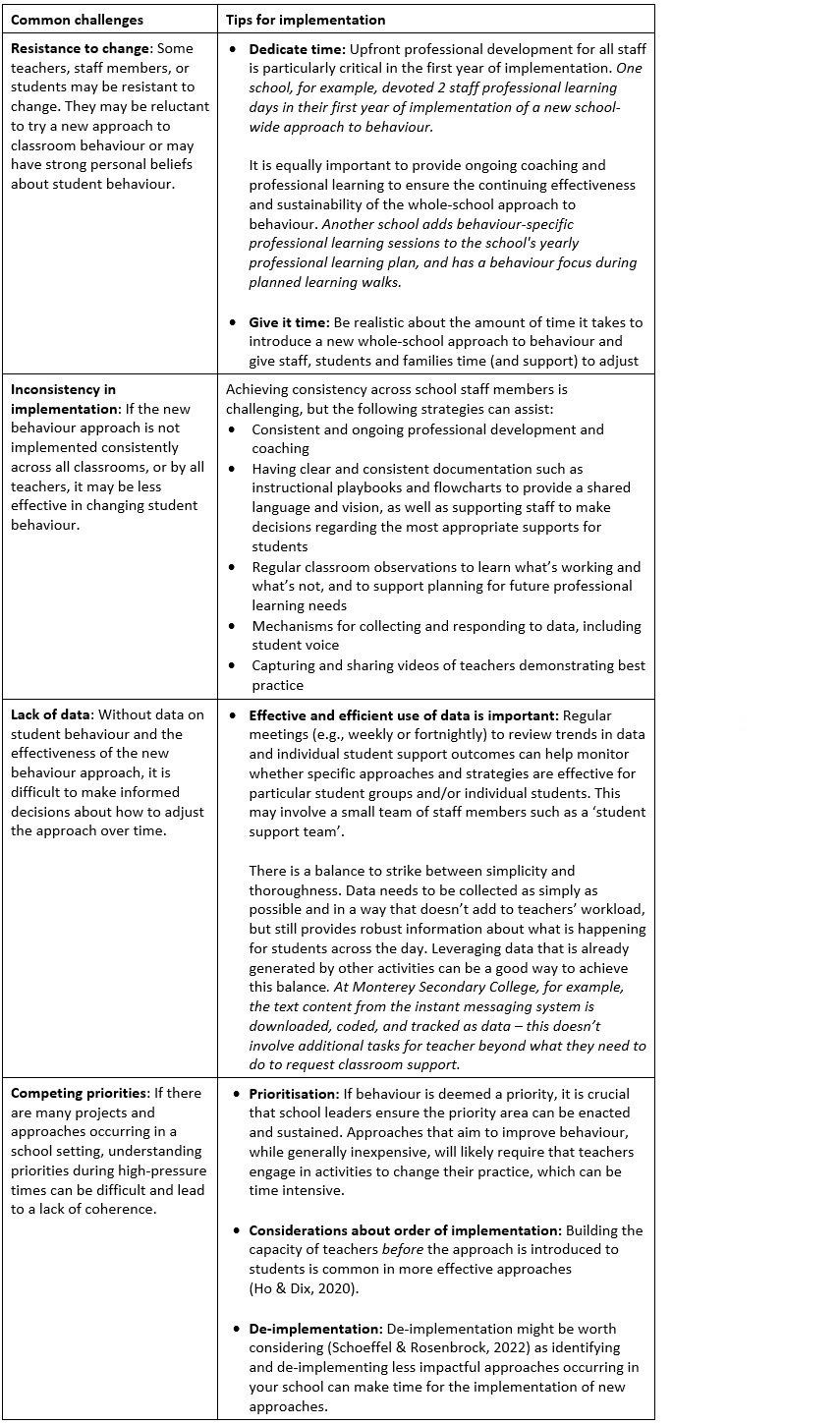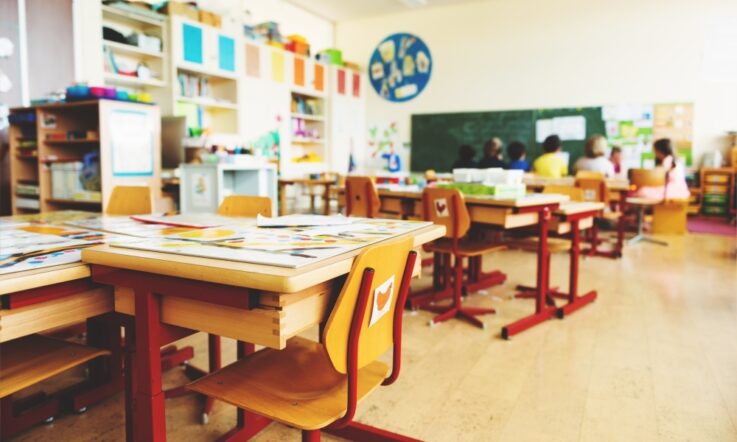While Australia has many students who meet behavioural expectations in classrooms and school environments, Australian teachers and students report disruptive behaviour as a challenge. Four out of 10 (43%) of Australian students surveyed reported that their classrooms were noisy and disruptive, well above the average of 33% of OECD countries (Thomson et al., 2017).
There is a need for schools to have consistent and clear approaches to behaviour that set and maintain behaviour expectations in lessons and throughout the school environment.
‘Behaviour’ can mean a range of ways students can act in school – including disruptive behaviours, prosocial behaviours, and learning behaviours – any behaviour that supports learning such as paying attention to the teacher or persevering with a difficult task.
Many interconnected factors influence behaviour, so behaviour supports are often used in conjunction with other strategies to support students’ overall learning, wellbeing and engagement.
A growing body of research evidence (Moore et al., 2019), alongside the recent experiences of teachers, school leaders and students (Hepburn et al., 2021; Longmuir et al., 2022), highlights the need to ensure all Australian schools have the most appropriate resources, and can use those resources effectively, when it comes to supporting behaviour.
Evidence for Learning’s (E4L) new Guidance Report, Effective behaviour supports in schools, distils 6 key recommendations from a global systematic review and input from Australian researchers and educators into the features of effective behaviour supports in Australian schools.
These 6 recommendations fall into 3 distinct categories. The first category ‘proactive’ contains recommendations that aim to prevent misbehaviour occurring through clear and predictable routines, strong relationships and school-wide norms. The second category ‘responsive’ includes guidance on appropriate and effective approaches for individual students who need further support. The final category is about ‘implementation’.
Figure 1. The 6 recommendations from Effective Behaviour Supports for Schools (Evidence for Learning, 2023)

This article focuses on implementation as something that can make (or break) any approach, program, or initiative, especially whole-school behaviour approaches.
Consistency is key when implementing an approach to behaviour. Even the best planned approach can be swiftly derailed by poor implementation. Decades of research into implementation quality indicates that no matter how good an approach or program is, it will have marginal impact if not implemented properly (Dix et al., 2012; Durlak & DuPre, 2008; Evidence for Learning, 2019)
To better understand how this recommendation is enacted, we spoke with 2 Australian school leaders – Tom Cain (Assistant Principal at Monterey Secondary College) and Karina Stocker (Instructional Coach at Docklands Primary School) – who shared their insights and experience of supporting students to meet expected behaviours in their schools.
Tom and Karina have identified a range of common implementation challenges related to behaviour supports and how they have addressed these challenges in their settings. These implementation challenges and tips are summarised in Table 1.
Table 1. Common challenges and implementation tips for overcoming them

In exploring any approach to behaviour in a school setting, school leaders should consider the school context – including size, stage of schooling, student needs, staffing and resources available – to identify potential implementation challenges and inform choices about how to implement behaviour approaches. Continuous monitoring of staff buy-in and how closely the behaviour approaches are being followed can help inform decisions about whether to adjust implementation activities. For example, if routines are not consistently observed across classrooms, additional coaching may be required.
No matter the approach, time is needed to embed the approach, often years. Implementation of whole-school programs can be slower and take more sustained coordination to see a change. Implementing such changes will require longer-term planning and monitoring. When assessing the success of a school-wide behaviour initiative, school leaders should consider:
- The aims of the approach
- The realistic rate and scale of change expected
- Anticipated pressure points: times or situations when maintaining the change may become difficult.
Ultimately, an effective approach to implementation of behaviour supports will lead to whole-school improvement that, if sustained, future students and their families will benefit from.
References
Dix, K. L., Slee, P. T., Lawson, M. J., & Keeves, J. P. (2012). Implementation quality of whole‐school mental health promotion and students’ academic performance. Child and adolescent mental health, 17(1), 45-51. https://doi.org/10.1111/j.1475-3588.2011.00608.x
Durlak, J. A., & DuPre, E. P. (2008). Implementation matters: A review of research on the influence of implementation on program outcomes and the factors affecting implementation. American Journal of Community Psychology, 41, 327-350. https://doi.org/10.1007/s10464-008-9165-0
Evidence for Learning. (2019). Putting Evidence to Work: A school's Guide to Implementation. Evidence for Learning. Available from: https://evidenceforlearning.org.au/education-evidence/guidance-reports/putting-evidence-to-work-a-schools-guide-to-implementation
Evidence for Learning. (2023). Guidance report: Effective behaviour supports in schools. Evidence for Learning. Available from: https://evidenceforlearning.org.au/education-evidence/guidance-reports/putting-evidence-to-work-a-schools-guide-to-implementation#nav-download-additional-tools
Hepburn, L., Beamish, W., & Alston-Knox, C. L. (2021). Classroom management practices commonly used by secondary school teachers: results from a Queensland survey. Australian Educational Researcher, 48(3), 485-505. https://doi.org/10.1007/s13384-020-00402-y/
Ho, P., & Dix, K. (2020. November 4). Implementing evidence-based strategies to improve student wellbeing. Teacher magazine. https://www.teachermagazine.com/au_en/articles/implementing-evidence-based-strategies-to-improve-student-wellbeing
Longmuir, F., Gallo Cordoba, B., Phillips, M., Allen, K.-A., & Moharami, M. (2022). Australian Teachers’ Perceptions of their Work in 2022 (Version 1). Monash University. https://doi.org/10.26180/21212891.v1
Moore, D., Benham-Clarke, S., Kenchington, R., Boyle, C., Ford, T., Hayes, R., & Rogers, M. (2019). Improving Behaviour in Schools: Evidence Review. Education Endowment Foundation.
Schoeffel, S. & Rosenbrock, M. (2022, October 24). Doing fewer things, better: The case for de-implementation. Teacher magazine. https://www.teachermagazine.com/au_en/articles/doing-fewer-things-better-the-case-for-de-implementation
Thomson, S., De Bortoli, L., & Underwood, C. (2017). PISA 2015: Reporting Australia's results. Australian Council for Educational Research (ACER). https://research.acer.edu.au/ozpisa/22
If you are a school leader looking to implement a new or adapted approach to behaviour in your school, consider the following questions:
- Can you identify potential implementation challenges that may arise in your setting, and do you have a plan to anticipate and/or respond to them?
- Is it feasible for this approach to be implemented? Is now the right time to implement the approach?
- Is there a sense of shared responsibility among staff and ideally students too, or is this new approach going to feel ‘done to’ the school community by leadership?
- Are those in the wider school community (beyond the leadership team and teachers) involved?
- Has ongoing professional learning – in both classroom management strategies and school-wide approaches aligned with your approach – been planned for school staff, including teaching assistants, office staff and everyone else who interacts with students?
- What impact will you expect to see in school if this approach to behaviour is successful? When would you expect to see an impact? How will this be measured?



